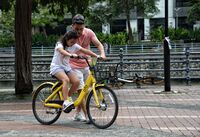Marusonya: Difference between revisions
No edit summary |
No edit summary |
||
| Line 206: | Line 206: | ||
=====Soap making===== | =====Soap making===== | ||
[[File:Esonian flower soap.jpg|150px|thumb|Traditional handmade soaps in a Marusonya shop]] | |||
====Textiles==== | ====Textiles==== | ||
Revision as of 16:27, 18 June 2021
Marusonya
Marusonya | |
|---|---|
| Country | |
| Region | Hirumi |
| Province | Marusonya |
| Population (2020) | |
| • City | 844,628 |
| • Rank | 2nd in Esonice |
| • Metro | 1,540,876 |
| • Total | 2,385,504 |
| Demonym | Marusonyan |
| Time zone | UTC-8 (Esonian standard time) |
| Post Code | ES-250 |
Marusonya, occasionally written in Anglish as Marsonya or Marsonia, is the second most populace city of Esonice with a population estimate of 844,628 residents as of 2020. The city is built on top several wetland islands at the mouth of the River Maru, separated by canals and linked by multiple bridges. For centuries, Marusonya has been one of Esonice's major centres of commerce, finance, craftsmanship , fashion, gastronomy and art, and is also considered as the beating heart of the Esonian cultural identity. Marusonya serves as the regional capital of Hirumi, and hosts many of Hirumi's institutions such as its regional parliament. The city also hosts the EOS Crisis Response office. Together with the outer districts of the city, which have 1,540,876 residents, the total population of the metropolitan area is 2,385,504. It is believed that in the future Marusonya together with Tamasu, --- and --- will form what has been dubbed as the "Greater Three Rivers Metropolitan" area which will be one of the most populated greater metropolitan areas of Esonice.
Etymology
The full meaning of Marusonya's name is uncertain. This is due to the meaning of the name "Maru" being uncertain, although the suffix "-sonya" means the "river mouth" so the name means "mouth of Maru". Marusonya first appeared in Huang records as 馬路口 (Malukou)
WIP
History
Prehistoric
Origins
Geography
Building Foundations
Cityscape
Governance
Districts
Transport
Waterways
After the 500s, major dredging projects were made across the Maru wetlands in an effort the raise the marshy ground above water. This resulted in the creation of a series of several interconnected canals that formed the basis of a flourishing nautical culture in the area. These canals proved to not only be vital to Marusonya's economic life, but to the inhabitants of the Maru river as a whole as it gave way to safe passage through the wetlands into the sea. Ever since, Marusonya has become the most important commercial centre in Eastern Esonice and its gateway to the outside wurld.
Today, the canals continue to serve a central role economic role in the region and the transportation of goods and people within the city. Several bridges were constructed across the series of canals for both pedestrian and driving uses. The latest bridge being constructed over the Maru River, finishing construction in 2011. A total of 5 bridges have been constructed over the Maru river to link the two parts of the city together. There are over 500 bridges in total in the city.
Public transport
Trams
Tramlines have been constructed across the city since the 1920s, the first line being created in 1923 that went across the Maru river. Since then trams have become a popular mode of public transport in Marusonya. Travel by tram in the city is also greatly encouraged in an effort to reduce and combat pollution created by cars and minimalize environmental impact.
Cycling
Travel by bike has become the most popular mode of personal transportation across the city, and great effort has been made by the city to maintain this trend. Infrastructural projects were started in the early 2000s to incorporate cycling to public roads and give cyclists a safe way to travel and minimise clashes between motorists and cyclists on roads. Starting in 2010s Marusonya introduced a bike hire scheme, with over 15,000 bikes available to hire at various locations in the city. Cycling is considered to be the most effective way in minimizing environmental impact by cars.




